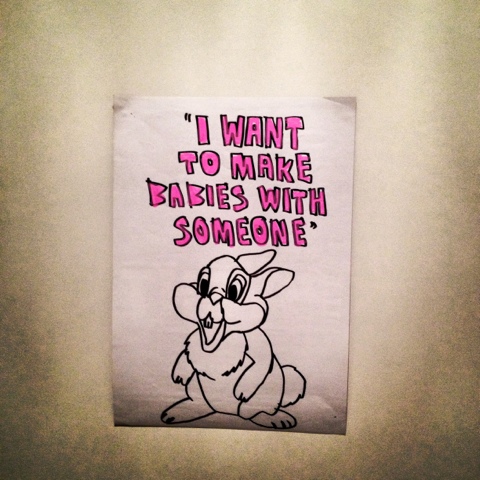The Yellow House was a radical enterprise started by Sydney artist Martin Sharp. Between 1970 and 1973, The Yellow House, near Kings Cross, was a piece of living art and a Mecca to Pop-art. The canvas was the house itself and almost every wall, floor and ceiling became part of the gallery. Many well-known artists helped to create the multi-media performance art space that may have been Australia’s first 24 hour-a-day ‘happening’.
Still to come - a community of Australian women who served as 'cheer-up girls' during wartime - and no, they weren't comfort women.
WOMAN: They hadn't been with women for a long time and, uh, they just wanted to leave the war all behind them for the time being.
GEORGE NEGUS: That later. You might remember the Yellow House in Sydney's Kings Cross back in the '70s. To say the least, it was a slightly bohemian community kicked off by artist Martin Sharp. It was a piece of living art, with the house itself as the canvas. Almost every wall, floor and ceiling became the gallery and some very well-known local artists helped turn it into a "multimedia performance art space" - a 'happening' for 24 hours a day.
MARTIN SHARP, ARTIST: It really came out of an idea of Van Gogh's, 'cause he called his studio the 'Yellow House' and he wanted to start a community of artists in the south, in the sunshine, you know, to get away from the madness of Paris. In a small way, he certainly did it. And I was inspired by that idea.
MARTIN SHARP ON ARCHIVAL FOOTAGE, 1971: It's an artist community in the south, in the sun, and probably one of the greatest pieces of conceptual art ever achieved.
PRESENTER ON ARCHIVAL FOOTAGE, 1971: Basically, it's simply the creative outpourings of the artist/cartoonist Martin Sharp and 15 people who decided to move in and live with him. There are painters, sculptors, writers and musicians and what they've produced is zany, clever, funny, serious...
GREG WEIGHT, PHOTOGRAPHER: It had a pop flavour, a cultural flavour, a deep history with Vincent and Gauguin and some of, you know, their...their...their influences.
BRUCE GOOLD, ARTIST: To get entree into the Yellow House, you had to do something creative, otherwise you sort of felt unwelcome. I know that Martin was very good at, if somebody walked in to sort of marvel at something, he would sort of nod towards a tin of gold paint and there'd be a brush there and you almost felt obliged to pick that up and to finish painting a gold window and eventually, there was most probably none of the original, um, wall space that hadn't somehow been adorned or sort of added to or transformed.
MARTIN SHARP: We weren't dealing with the usual sort of gallery system, 'cause we were running the gallery, the artists were running the gallery. So it was a different sort of scene altogether.
ALBIE THOMS, FILMMAKER: We had people painting walls, but also performing in cabarets and plays, helping show films and things - so everyone became involved on multiple levels. Little Nell starred in the cabarets and she tap-danced at the opening of Martin's first exhibition there.
LITTLE NELL ON ARCHIVAL FOOTAGE: I sang wherever I could - at the Yellow House in Sydney, for instance. Painters and artistes were the first to encourage me. Well, they didn't care that I wasn't Little Pattie.
MARTIN SHARP: And we'd keep it open at night and it was a different... Not a business, it was a...a theatre of sorts, I suppose.
PETER KINGSTON, ARTIST: After 9:00 at night, taxis would start arriving out the front with people who'd been to dinner. They'd just come down and see what was going on at the Yellow House. Leslie Walford and Jeffrey Smart - people would be getting...
ALBIE THOMS: Well, and the Pink Floyd came one night and stayed and watched one of the films we were showing. And, uh, that goggle-eyed fellow...um, Marty Feldman came in one night. And, you know, as Bruce said, he arrived late and the place was basically shut - he was wandering around in the dark. And I'm walking through, going to my room, and suddenly these eyes came through the dark. And it was Marty Feldman the comedian, and he wanted to know how to get out. Once you got in, it was very hard getting out because it was like a big, uh, labyrinth.
ALBIE THOMS IN ARCHIVAL FOOTAGE: It's in a constant state of non-control. Therefore, anything can happen any moment of the day - you'll always be surprised in the Yellow House.
ALBIE THOMS: You'd wake up in the morning and find a room had been transformed overnight. Martin and people would keep working through the night. So the whole house was an installation artwork. And, uh, it was installed but it became a performance space - so the inside installation, performances took place. So it was a multimedia art form.
BRUCE GOOLD: There wasn't necessarily an enormous budget and it was what you could sort of find, sometimes, you know. It was locating the giant red velvet theatre curtain and sort of draping it to help create the Belgian bourgeois interior for the Magrittes and things like that.
GREG WEIGHT: Here we've got great works of art that were painted on the walls. Any of those more spectacular rooms - the Stone Room or the Puppet Theatre and the Cloud Room - could have been in some way utilised, but, as it happened, there wasn't the administration or the organisation to keep it that way. So, it changed.
MARTIN SHARP: It did work, you know? Somehow it worked. I think it was just because there was so much good will there at the time, you know? It was...that was really the inspiration for it - you know, people's willingness to help,






































































